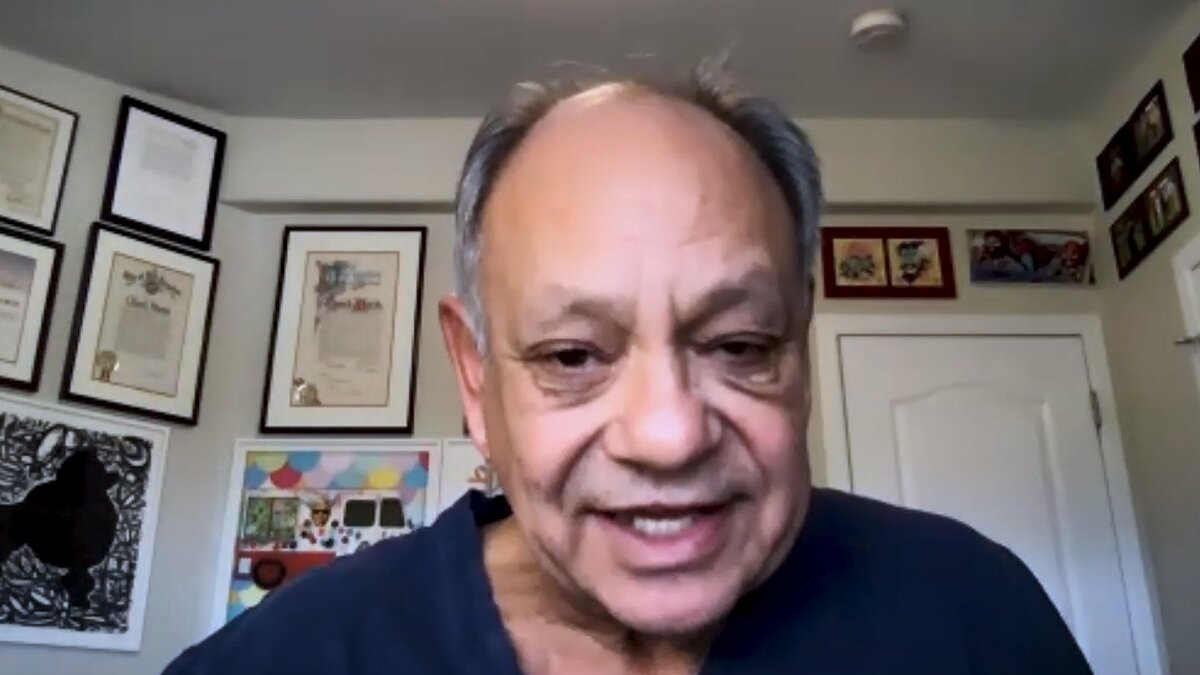Actor Cheech Marin brings personal collection of Chicano art to Colorado

COLORADO SPRINGS, Colo. — “I love it!” actor and art collector Cheech Marin exclaims, seeing the walls of the Fine Arts Center for the first time via Zoom.
Of course, he’s seen the works before — he owns them.
Exhibiting and sharing Chicano community, history, and art are a full-time passion for Marin, who became famous during the 1970s as one half of the iconic comedy duo Cheech & Chong. Two dozen films, television series and countless comedy tours later, Marin found himself in the perfect position to begin to acquire a lifelong love: art.
The exhibit is called "Papel Chicano Dos: Works on Paper from the Collection of Cheech Marin." It will be on display at the Colorado Springs Fine Arts Center at Colorado College until June 26, 2021.
Marin said the exhibit represents “a small fraction” of a personal collection he has been adding to for over 30 years.
A studied art history buff and collector, Marin personally seeks out each artist’s work for his collection.
“I wasn’t a zillionaire hiring other people to collect for me. I was working on it,” he said. “So the pieces in the collection are very heartfelt. I don’t pick art just to have it.”
Raised in a blue-collar, working class Chicano family in Los Angeles, Marin grew up with a playful competitiveness with his cousins, who urged each other to seek academic study.

“My head cousin, Louie, assigned us all subjects to learn about and bring back to the group,” he said. “And I got art! So I studied art from a very early age.”
After looking at every art book in the library, Marin said he was hooked, finding joy in identifying major and minor artists, methods, and techniques.
“By the time I got to actually being able to purchase some art, I knew a lot about it,” he said.
Marin said he found himself “in an extreme lucky position” to begin amassing works by Chicano artists, both celebrated and unknown.
“I was the right guy at the right time, with money. And I was a known celebrity,” he said. ”All those factors came together.”
His collection now encompasses over 700 pieces. The distinction? “I always look for craftsmanship,” he said.
The innovative idea that spurred this touring exhibit into motion came from friends.
“I had this big collection, and I showed my art friends. And they said, ‘Well, you’ve got to show it! Because it does you no good in storage, or under the bed. People have to see this.’”
Nearly a decade of planning followed. Now, parts of his collection have visited over 55 museums and galleries nationwide— unheard of, he says, for a private art stash.
Marin found his personal collection of Chicano art outnumbered most venue’s where he was showing.
“At most museums, I was telling them, ‘I have this collection — because you don’t,’” he said.
“Chicano art is American art,” he continued. “Chicano is one definition of America — European plus Mexican — it defines a lot of what America is now. Chicano art is where traditional Mexican meets American pop.”
Marin said the Chicano art movement began as the visual arm of the Chicano Civil Rights movement in the 1960s.
“Original Chicano artists like Carlos Almaraz and Frank Romero were the sign painters for that revolution,” Marin explained. “They did the backdrops and the placards to show a visual sense of the political aspiration.”
For more on the Colorado Chicano Civil Rights Movement, watch Colorado Experience: Justicia y Libertad
Sonia Romero — the daughter of Frank Romero — has contemporary work depicted in this show.
“This exhibit lends itself to an appreciation of the diversity of our country. A lot of people don’t even know what a Chicano is. They think it’s a tasty cheese snack or something. ‘Ooh, a Chicano! I love crispy Chicanos, they’re so good!’” he laughed.
“It’s a gradual understanding,” he continued. “And the only way there is a gradual acceptance, is if you see it. And that’s what this touring exhibit is all about.”
After stewarding a large exhibit for many years, Marin decided to bring facets of his collection to more specific audiences, designing smaller shows that could easily fit into regional museums and galleries. It cuts down on the long lead times required for larger museums—often years, he says—and allows the works to enter communities that are usually overlooked by larger art exhibits.

“It’s nice to play the Smithsonian, it’s nice to play LACMA. Those are important institutions, and it’s a verification of the work, to be sure,” he said. “But I wanted to get this work into spaces that really serve their communities. To play a Waco, Texas, or a Colorado Springs, Colorado — it ultimately helps more people see the work.”
“My mantra had always been, ‘You can’t love or hate Chicano art unless you see it,’” Marin said. “And now when I see art that says something, then I’m on a mission to get it and to show it. I’m so glad we can bring it to people.”
A year from now, Marin will help unveil The Cheech Marin Center for Chicano Art, Culture & Industry, or simply “The Cheech,” a 61,420 square foot art and cultural center in Riverside, California. It’s perhaps the largest Chicano art collection in the United States.
“It’s going to be a dynamic interaction between the community and the museum,” Marin said. “It feels very empowering.”
Marin said he’ll give the majority of his collection — including paintings, videos, sculpture, and photography — to The Cheech for permanent display, while a portion of the work will continue to tour nationally and internationally.
“It was so much fun collecting this art,” Marin said. “I don’t know if I’ve ever done anything that was more fun.”
To learn more about the exhibit in Colorado Springs, visit the Fine Arts Center website.
